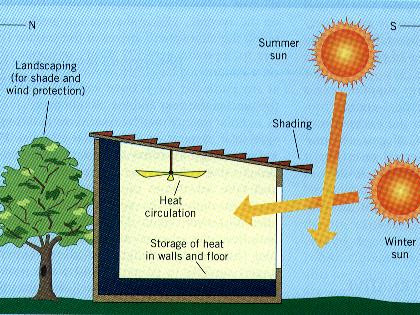 When shopping for your house plan with an attached garage it is highly recommended to know how it will be oriented on the land in order to obtain maximal sunlight and enjoy the benefits of passive energy in your garage and in the viable part of the home. For certain homeowners, or future homeowners, the location of the garage may seem of little consequence. These unfortunate individuals might find out too late that the natural lighting, which is enhanced by abundant sunlight, is deficient or even non existent. In cooler climates, sunny breaks have as much of a positive impact on our morale as they do as a source of passive energy which increases with the warming of receptive floor surfaces and the accumulated heat that they release, during the evening for example. It is therefore a good idea to locate the garage on the north side of the home. If this is not possible, the second choice would be a north-west orientation because of the dominant winds from the west. A north-easterly orientation is the third choice. In order to optimize the orientation of the home and its garage, the right reading reverse option is an excellent way to locate your home at a relatively low cost.
When shopping for your house plan with an attached garage it is highly recommended to know how it will be oriented on the land in order to obtain maximal sunlight and enjoy the benefits of passive energy in your garage and in the viable part of the home. For certain homeowners, or future homeowners, the location of the garage may seem of little consequence. These unfortunate individuals might find out too late that the natural lighting, which is enhanced by abundant sunlight, is deficient or even non existent. In cooler climates, sunny breaks have as much of a positive impact on our morale as they do as a source of passive energy which increases with the warming of receptive floor surfaces and the accumulated heat that they release, during the evening for example. It is therefore a good idea to locate the garage on the north side of the home. If this is not possible, the second choice would be a north-west orientation because of the dominant winds from the west. A north-easterly orientation is the third choice. In order to optimize the orientation of the home and its garage, the right reading reverse option is an excellent way to locate your home at a relatively low cost. 
This new style of garage door features tempered, thermal glass. Its clean lines make it a perfect addition to today’s contemporary home designs with the accent on security. It is an updated version of the automobile mechanic’s garage door whose technology has reached the residential market. The tempered glass on the interior, thermal, side of the door ensures that if there is a mishap which breaks the glass it will not shatter into shards but will break into relatively harmless granules, much as a windshield.

If you are contemplating a model that has a basement level garage, there are a few things that are worth considering in order to avoid unfortunate surprises such as water infiltration during heavy down pours and damage to the foundation during the freeze-thaw cycle.
The majority of the problems are related to the excessive slope created by the access zone which favors drainage towards the garage. Adherence to a few basic principles during the process will help ensure a more reliable installation. Adequate protection for the foundation against the freeze-thaw cycle is without doubt the first priority. A basement level garage must be seated on a foundation that extends in depth beyond the main foundation of the home. If the support walls are adjacent to the access slope within 5 feet, you will need a five foot protection zone beyond the walls as well as the door. A moderate access slope: Due to the municipal requirements or set back, basement level garages often have extreme slopes which are all but non functional for a car that has a manual transmission. This is a reality for many lots and the basement garage should not be considered unless the maximal access slope of between 3% and 8% can be achieved. A hump at the start of the driveway, before the slope starts, is a simple yet essential way to protect against water infiltration and acts as an effective barrier to water accumulated in the street during heavy down pours. In colder climates it is imperative as during the unseasonable thaws that happen in the winter, when water evacuation systems at street level are frozen and may even be non functional, the water that rises in the street will tend to flow down into the basements of unprotected entrances. A separate drainage system in front of the garage door which is completely independent from the drain for the water from around the foundation is essential. This drain must be kept clean and free from any leaves, gravel or other material and must be maintained two or three times a year. It’s the only way to ensure its efficiency as an unmaintained drain is an invitation for unwanted surprises.
